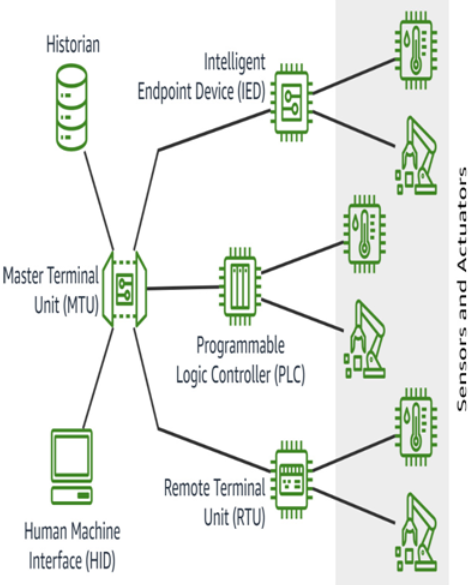Supervisory Control and Data Acquisition – Getting Started with Edge Computing on AWS
Supervisory Control and Data Acquisition (SCADA) systems are used in industrial settings to monitor and control processes and infrastructure in various industries – including manufacturing, utilities, oil and gas, water management, and transportation. SCADA systems enable real-time data collection and processing from remote equipment, allowing operators to supervise and manage industrial processes from a centralized location:

Figure 1.8 – Typical SCADA system architecture
A typical SCADA system consists of several components, including the following:
Remote Terminal Units (RTUs), Intelligent Electronic Devices (IEDs), or Programmable Logic Controllers (PLCs)
These devices are responsible for collecting data from sensors and controlling equipment at remote sites. They communicate with the central SCADA system to transmit data and receive control commands.
Sensors and actuators
Sensors measure various process parameters, such as temperature, pressure, and flow rate, while actuators perform control actions, such as opening or closing valves and adjusting motor speeds. These devices interface with the RTUs or PLCs to provide data and receive control signals.
Human-machine interface (HMI)
An HMI is a graphical interface that allows operators to interact with the SCADA system, visualizing process data, and issuing control commands. HMIs typically display real-time data in the form of charts, graphs, and schematics, enabling operators to monitor system status and make informed decisions.
Historians
A historian is a system that holds an archive of past data samples taken from PLCs, RTUs, sensors, actuators, and the SCADA system itself. These are similar to Time Series Databases (TSDBs) such as CrateDB or TimescaleDB.
SCADA server
The SCADA server hosts the software that manages data collection, processing, and storage. It also handles alarm management, event logging, and reporting functions. The software enables operators to configure the system, define control logic, and analyze historical data.
AWS integration with SCADA systems
While there has been an explosion in the number of inexpensive sensors that natively speak IoT protocols such as MQTT, doing IIoT with AWS does not entail a complete replacement of existing systems. Services such as AWS IoT SiteWise Edge help customers interface with these protocols to merge existing data sources with new ones. In fact, the analysis of historical data from these systems helps customers realize value more quickly than starting from ground zero. AWS IoT TwinMaker can, in turn, consume this normalized data to produce digital twins of industrial operations.
When store-and-forward capabilities are desirable, or ML inferences need to be made locally, AWS IoT Greengrass is an ideal solution. It can run on your own hardware, or hardware provided by AWS in the form of AWS Outposts and AWS Snow Family.
As use cases go, DDIL, MEC, AR/VR, and IIoT all seem rather distinct from one another. How does AWS go about taking a unified approach to helping customers with all four? This is what we’ll cover in the next section.
You may also like
Archives
- August 2024
- July 2024
- June 2024
- May 2024
- April 2024
- March 2024
- February 2024
- January 2024
- December 2023
- November 2023
- October 2023
- September 2023
- August 2023
- July 2023
- May 2023
- April 2023
- February 2023
- January 2023
- November 2022
- October 2022
- September 2022
- August 2022
- July 2022
- June 2022
- May 2022
- April 2022
- December 2021
- November 2021
- October 2021
- September 2021
- June 2021
Calendar
| M | T | W | T | F | S | S |
|---|---|---|---|---|---|---|
| 1 | 2 | 3 | 4 | 5 | 6 | |
| 7 | 8 | 9 | 10 | 11 | 12 | 13 |
| 14 | 15 | 16 | 17 | 18 | 19 | 20 |
| 21 | 22 | 23 | 24 | 25 | 26 | 27 |
| 28 | 29 | 30 | ||||
Leave a Reply